|
Issue 1 / 2001
Tibetan
Medicine
- Feature
 In
many
of his teachings, the Buddha used disease and healing as metaphors to
illustrate
his philosophy of the human condition. From the Buddhist perspective,
physical
illness is inextricably bound with mental, social and spiritual illness.
Thus
the Buddhist medical system is more than studies of anatomy,
physiopathology and
pharmacopoeia. It is a guide to 'right living' and involves the spiritual
aspects of healing as well.
In
many
of his teachings, the Buddha used disease and healing as metaphors to
illustrate
his philosophy of the human condition. From the Buddhist perspective,
physical
illness is inextricably bound with mental, social and spiritual illness.
Thus
the Buddhist medical system is more than studies of anatomy,
physiopathology and
pharmacopoeia. It is a guide to 'right living' and involves the spiritual
aspects of healing as well.
The
Maha Kumbh 2001 - &
the best of Kumbh photos
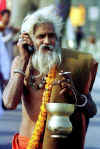 Seldom do 70 million people congregate
over a period of few weeks to seek salvation – irrespective of their
individual belief and creed or ethos. The Mahakumbh at Allahabad, which
began on 9 January 2001, is perhaps the only spiritual event that gathers
such mega numbers of humanity in one place in the true spirit of ‘ Jagat
Kutumbkam’ – or one global family. It is a secular tradition shared by
people of all faiths and cultures. It is considered by many to symbolise the
soul of Indian culture and thought. Seldom do 70 million people congregate
over a period of few weeks to seek salvation – irrespective of their
individual belief and creed or ethos. The Mahakumbh at Allahabad, which
began on 9 January 2001, is perhaps the only spiritual event that gathers
such mega numbers of humanity in one place in the true spirit of ‘ Jagat
Kutumbkam’ – or one global family. It is a secular tradition shared by
people of all faiths and cultures. It is considered by many to symbolise the
soul of Indian culture and thought.
Y2K
- South Asian women in headlines
  The year 2000 was the
year of headlines for south Asian women. Jhumpa Lahiri did it - by winning
the Pulitzer Prize - Karnam Malleshwari and Susanthika Jayasinghe won bronze
medals at the Sydney Olympics - Lara Dutta, Priyanka Chopra, Diya Mirza and
Aditi Govitrikar became the beauties with brains. The year 2000 was the
year of headlines for south Asian women. Jhumpa Lahiri did it - by winning
the Pulitzer Prize - Karnam Malleshwari and Susanthika Jayasinghe won bronze
medals at the Sydney Olympics - Lara Dutta, Priyanka Chopra, Diya Mirza and
Aditi Govitrikar became the beauties with brains.
'The
Moonlight Garden' -
Mystery unraveled at Taj  There has been much
speculation and academic interest in whether or not Shahjahan planned to
build his tomb across the river from the Taj. Foreign travellers who visited
India during Shahjahan’s rule thought he might. A lone surviving tower and
the remnants of a wall on the opposite bank of the river, suggested there
may have been something planned but nobody really knew what. ‘The
Moonlight Garden’ tells you just what it was – a Moonlight Garden called
Mahtab Bagh - and dispels the myth of another Taj in black marble across
from the Taj in white. There has been much
speculation and academic interest in whether or not Shahjahan planned to
build his tomb across the river from the Taj. Foreign travellers who visited
India during Shahjahan’s rule thought he might. A lone surviving tower and
the remnants of a wall on the opposite bank of the river, suggested there
may have been something planned but nobody really knew what. ‘The
Moonlight Garden’ tells you just what it was – a Moonlight Garden called
Mahtab Bagh - and dispels the myth of another Taj in black marble across
from the Taj in white.
Ritu
Kumar - Designing for 'Queens' 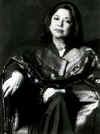 The winners of all three International
Beauty titles of 2000 were attired by designer Ritu Kumar. The high
priestess of Indian haute couture has dressed up 17 young ladies of whom 13
have won the Miss India pageant and seven have gone on to win the Miss
World, Miss Universe, and Miss Asia-Pacific titles. The winners of all three International
Beauty titles of 2000 were attired by designer Ritu Kumar. The high
priestess of Indian haute couture has dressed up 17 young ladies of whom 13
have won the Miss India pageant and seven have gone on to win the Miss
World, Miss Universe, and Miss Asia-Pacific titles.
'India
- Through The Lens'
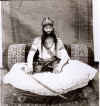 'India - Through the Lens' - an
exhibition of photographs taken during the period 1840 - 1911 opened at the
Arthur M. Sackler Gallery in Washington DC, last month. The photographs range from
panoramic views and architectural and ethnographic documentation to
portraits of Maharajas and the British way of life in India - and includes
photographs taken by the Indian photographer Lala Deen Dayal. The exhibition has several visual
short stories - and many more statements. 'India - Through the Lens' - an
exhibition of photographs taken during the period 1840 - 1911 opened at the
Arthur M. Sackler Gallery in Washington DC, last month. The photographs range from
panoramic views and architectural and ethnographic documentation to
portraits of Maharajas and the British way of life in India - and includes
photographs taken by the Indian photographer Lala Deen Dayal. The exhibition has several visual
short stories - and many more statements.
'Silk
Road on Wheels'
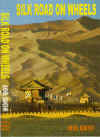 'Silk Road on Wheels' is a travelogue - a witty account of a
remarkable journey undertaken by the author, together with scholars from
India, China and Europe, along the Old Silk Route. The author, Akhil Bakshi,
led the expedition that drove across Uzbekistan, Kazakhastan, Chinese
Turkestan and Tibet.The book is a humorous, yet keenly
perceptive, narrative of everyday life in this area and about its people - a land where people
in small towns are addicted to the newly introduced game of pool - they play
on the streets, go clubbing at night - and monasteries where monks can learn to
fly! 'Silk Road on Wheels' is a travelogue - a witty account of a
remarkable journey undertaken by the author, together with scholars from
India, China and Europe, along the Old Silk Route. The author, Akhil Bakshi,
led the expedition that drove across Uzbekistan, Kazakhastan, Chinese
Turkestan and Tibet.The book is a humorous, yet keenly
perceptive, narrative of everyday life in this area and about its people - a land where people
in small towns are addicted to the newly introduced game of pool - they play
on the streets, go clubbing at night - and monasteries where monks can learn to
fly!
Shamshad Hussain -
& Love in the Time of Cholera
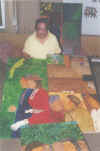 It took
Shamshad Hussain over 40 years to emerge from the shadows of his father -
the celebrity artist M.F. Hussain. One of the very few who have managed to
make a name in a field dominated by a father, Shamshad has defied the odds
to struggle and emerge as one of the pioneers of contemporary art in
India. Today,
Shamshad's works sell as soon as he can paint them. And the art world looks
up in anticipation whenever he announces an exhibition. His latest body of
work was titled Love In The Time of Cholera. " Its
one of my most significant series. There's despair and hope running through
my canvasses....." It took
Shamshad Hussain over 40 years to emerge from the shadows of his father -
the celebrity artist M.F. Hussain. One of the very few who have managed to
make a name in a field dominated by a father, Shamshad has defied the odds
to struggle and emerge as one of the pioneers of contemporary art in
India. Today,
Shamshad's works sell as soon as he can paint them. And the art world looks
up in anticipation whenever he announces an exhibition. His latest body of
work was titled Love In The Time of Cholera. " Its
one of my most significant series. There's despair and hope running through
my canvasses....."
And other articles .....
Disclaimer |








